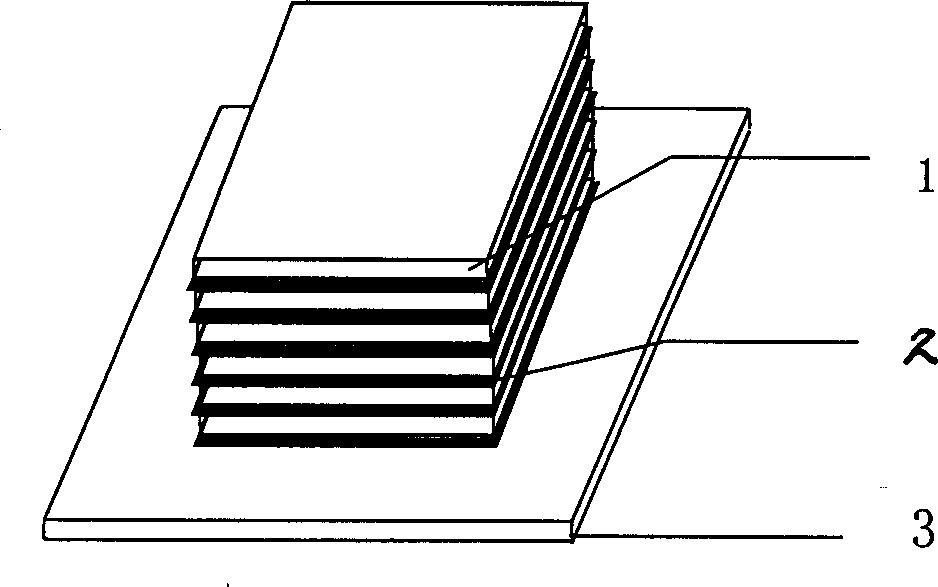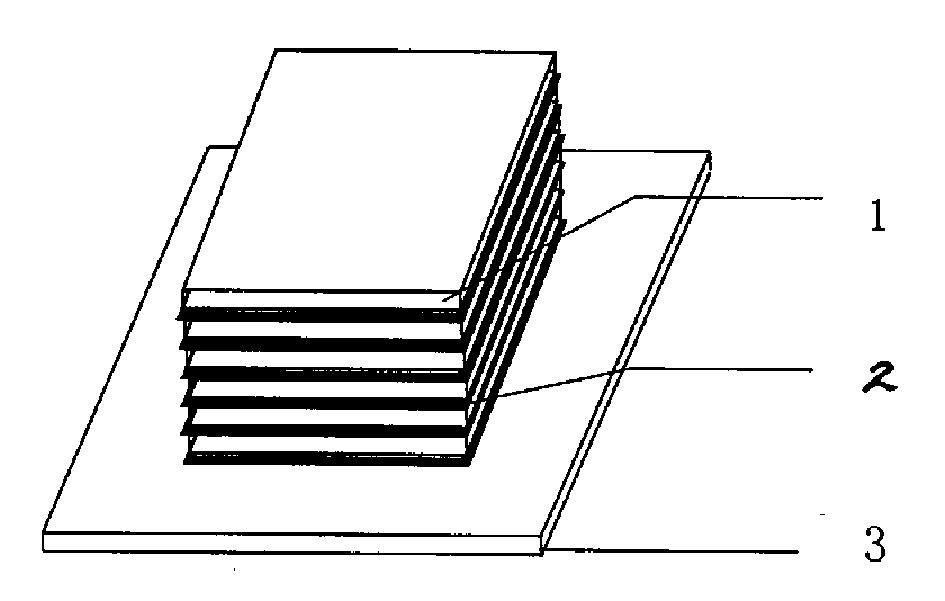Production method of devitrified glass plate
A technology of glass-ceramics and production methods, applied in the field of building materials, can solve the problems of easy warping of plates, difficult discharge of air bubbles, high porosity, etc., and achieve the effects of good flatness, high production efficiency, and high density
- Summary
- Abstract
- Description
- Claims
- Application Information
AI Technical Summary
Problems solved by technology
Method used
Image
Examples
Embodiment 1
[0023] The following components are selected as the raw materials (% by weight) for preparing ultra-thin glass-ceramic plates:
[0024] SiO 2 64, Al 2 o 3 6, CaO 16, ZnO 4, BaO 4, Na 2 O+K 2 O 6,
[0025] where Na 2 O and K 2 The weight ratio of O is 1:1
[0026] (1) Mix the above raw materials evenly, put them into a glass melting furnace and heat them to 1400°C to melt into molten glass.
[0027] (2) Prepare the molten glass into glass plates with a thickness of 5 mm by using the float glass production process, and cut them into glass plates of 1.22×2.42 m respectively.
[0028] (3) Stack six 5mm thick glass plates together and put them on the shed plate of the kiln car. Insert high temperature resistant release paper between layers, such as figure 1 shown.
[0029] (4) Send the kiln car into the tunnel kiln for crystallization, the maximum heating temperature is 900°C, thus forming an ultra-thin glass-ceramic plate. The entire crystallization cycle takes 18 ho...
Embodiment 2
[0032] The following components are selected as raw materials (% by weight) for the preparation of glass-ceramic plates:
[0033] SiO 2 50, Al 2 o 3 10, CaO 18, ZnO 10, Na 2 O+K 2 O 11,Cr 2 o 3 1,
[0034] where Na 2 O and K 2 The weight ratio of O is 3:1
[0035] (1) Mix the above raw materials evenly, put them into a glass melting furnace and heat them to 1500°C to melt into molten glass.
[0036] (2) Prepare the molten glass into a glass plate with a thickness of 8 mm by using the flat-drawn glass production process, and cut the glass plate into a size of 1.22×1.22m.
[0037] (3) Stack three 8mm thick glass plates together and put them on the shed plate of the kiln car. A high temperature resistant talcum powder isolation layer is placed between the layers.
[0038] (4) Send the kiln car into the shuttle kiln, and crystallize at a temperature of 900°C to form a glass-ceramic thin plate. The entire crystallization cycle takes 16 hours.
[0039] (5) After lea...
Embodiment 3
[0041] The following components are selected as the raw materials (% by weight) for preparing the composite glass-ceramic plate:
[0042] SiO 2 60, Al 2 o 3 8, CaO 15, BaO 6, Na 2 O+K 2 O9, ZrO 2 1. TiO 2 1,
[0043] where Na 2 O and K 2 The weight ratio of O is 2:1
[0044] (1) Mix the above raw materials evenly, put them into a glass melting furnace and heat them to 1500°C to melt into molten glass.
[0045] (2) Prepare the molten glass into a glass plate with a thickness of 3 mm by using the flat-drawn glass production process, and cut the glass plate into a size of 1.22×2.42 m.
[0046] (3) Stack six 3mm thick glass plates together and put them on the shed plate of the kiln car. There is no isolation layer between the layers, and an isolation layer of alumina powder is placed between the glass plate and the shed plate.
[0047] (4) Send the kiln car into the tunnel kiln for heating and heat preservation to bond and crystallize the glass plates. The maximum ...
PUM
| Property | Measurement | Unit |
|---|---|---|
| Thickness | aaaaa | aaaaa |
| Thickness | aaaaa | aaaaa |
| Thickness | aaaaa | aaaaa |
Abstract
Description
Claims
Application Information
 Login to View More
Login to View More - R&D
- Intellectual Property
- Life Sciences
- Materials
- Tech Scout
- Unparalleled Data Quality
- Higher Quality Content
- 60% Fewer Hallucinations
Browse by: Latest US Patents, China's latest patents, Technical Efficacy Thesaurus, Application Domain, Technology Topic, Popular Technical Reports.
© 2025 PatSnap. All rights reserved.Legal|Privacy policy|Modern Slavery Act Transparency Statement|Sitemap|About US| Contact US: help@patsnap.com


